The cosmic microwave background (CMB) radiation — the faint glow that simmers all around us, a remnant of the extreme heat of creation — is hailed as the Rosetta stone of cosmology. Locked inside the subtle patterns of the microwave sky are the secrets of the universe; they await experiments capable of discerning them. Now, a new instrument called the Sunyaev-Zeldovich Array (SZA) is poised to do just that. The SZA, which will uncover crucial details about both the contents and history of the universe, marks the latest frontier in CMB observation.
As the CMB photons travel toward Earth along their 14 billion-light-year journey from the universe’s infancy, they occasionally pass through the hot, gaseous atmosphere that resides in gaps between galaxies in large clusters. There, temperatures are too intense for even atoms to hold together, and so, high-energy electrons roam solo. When the CMB photons calmly sail through, a handful of them (about one in one hundred) collide with these electrons. The electrons hand off some of their energy to the photons, slightly altering the light’s frequency. This type of transaction shows up as a distortion signature — called the Sunyaev-Zeldovich effect after the astrophysicists who first predicted it — in maps of the microwave sky. It’s a challenge for observers to detect, but its presence can lead them to answers to some of cosmology’s most pressing questions.
The SZA — an 8-dish, 3.5-meter radio telescope in Owens Valley, California — has the sensitivity to measure the effect. This is impressive considering the temperature is distorted by roughly one thousandth of a degree Kelvin. But searching the sky for these distortions is worth the effort for a University of Chicago team and for their collaborators at NASA’s Marshall Space Flight Center, Columbia University, and Caltech. That’s because the SZ effect is the single most effective way to find every last galaxy cluster above a certain mass — 10,000 times more massive than our Milky Way Galaxy. Usually, the farther away an object lies, the harder it is to find. Remarkably, though, the strength of the SZ effect is independent of distance, so the SZA is capable of finding galaxy clusters as far back in space and time as such structures have existed.
Once the SZA finds evidence of a cluster’s presence lurking in the CMB, optical telescopes will be used to determine the cluster’s redshift and, in turn, its distance. Then, the team can get a clear picture of how many clusters existed at each stage in the universe’s past. “The SZA will see when clusters first formed,” explains SZA principal investigator John Carlstrom of the University of Chicago. “It will immediately test our theories of how structure formed in the universe and how it evolved in time. . . . It will tell us right away if there are any big surprises out there.”
The rate of galaxy-cluster formation is critically dependent on how much matter is in the universe, including dark matter, as well as how matter was initially distributed. The SZA, then, will tell us the density of ordinary and dark matter and also provide important clues to the conditions of the cosmos’s beginning.
What’s more, the SZA will begin to paint a picture of the expansion history of the universe — a key to solving the dark-energy mystery. As space expands, it becomes harder for gravity to sculpt matter into huge structures like galaxy clusters. When dark energy kicked in and began to accelerate the expansion, gravity began to lose the cosmic tug-of-war. Astronomers can trace this history more closely by looking at how clusters have evolved over time.
“If we can use the SZ effect to get a complete inventory of these very large objects and then map them out in time, we can see how these two forces have interacted as the universe has evolved,” Carlstrom says. “When was gravity really winning, and when did the dark energy start to win?”
A detailed expansion history could reveal the identity of dark energy, which cosmologists believe makes up more than 70 percent of the contents of the cosmos. Different theoretical models are distinguished by how the strength of dark energy changes over time. The SZA, however, is capable of surveying only a relatively small portion of the sky, roughly 10 square degrees. But the instrument is a precursor of the much more powerful South Pole Telescope, another project led by Carlstrom and scheduled for deployment to the South Pole in December 2006. By comparison, the South Pole Telescope will scan 4,000 square degrees and provide a much more comprehensive account of the history of expansion.
“It will tell us how the dark energy has evolved with the expansion of the universe,” says Carlstrom. “That is one of the critical ways to get at the nature of the dark energy. Is it the vacuum energy, is it quintessence, or is it something more exotic?”
In the meantime, the SZA will start collecting data this summer. It will begin to decode the cryptic message of the microwaves and confirm the ever-stranger portrait of the universe with which cosmologists are now confronted. And who knows — in seeking so many answers, it may reveal some brand new mysteries as well.










